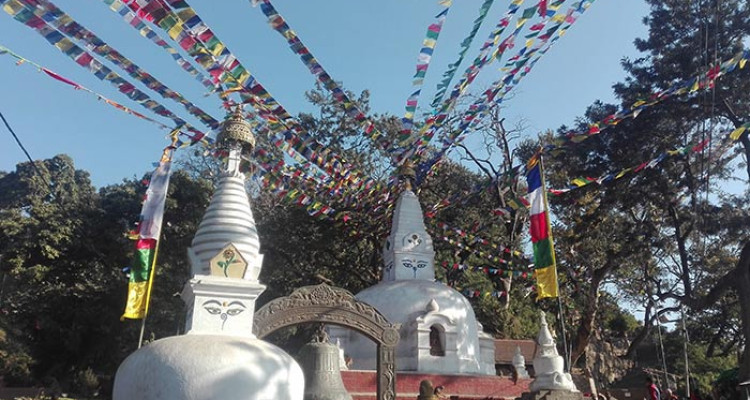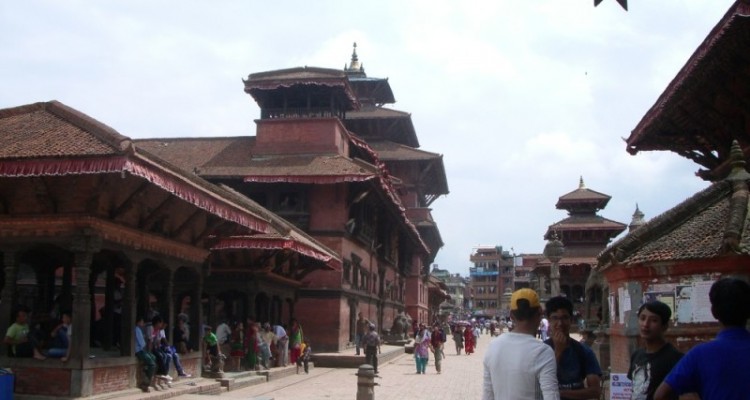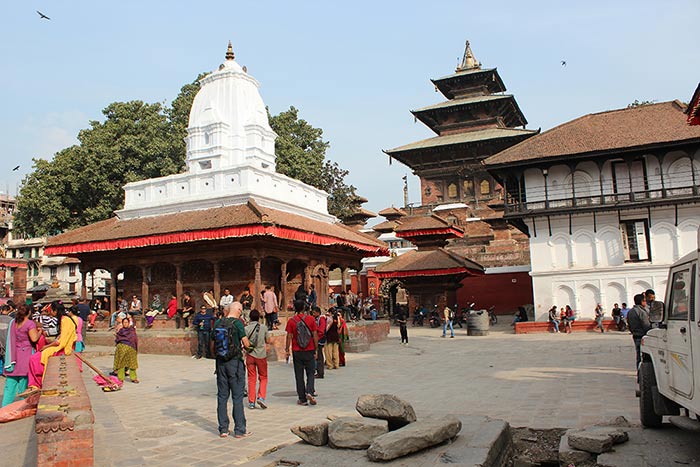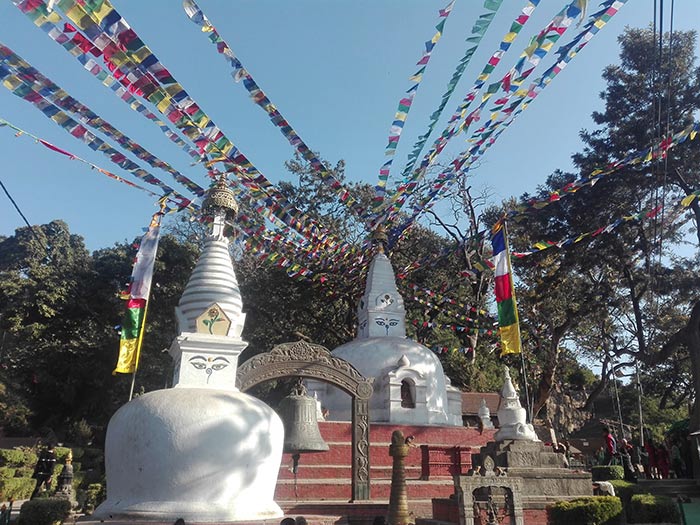May 4, 2018

Welcome to the vibrant city of Kathmandu, nestled in the heart of the Himalayas! Our Kathmandu Day Tour is an immersive experience that will allow you to discover the unique cultural and historical landmarks of this enchanting city.
We’ll begin our tour by exploring the narrow, bustling streets of Kathmandu’s old city, where you’ll encounter colorful markets, ancient temples, and friendly locals. As we wander through the maze-like alleyways, you’ll be transported back in time to a bygone era of spice traders, merchants, and holy men.
Next, we’ll visit the famous Swayambhunath Stupa, also known as the Monkey Temple, which sits atop a hill overlooking the city. Here, you’ll be able to admire the stunning views of Kathmandu Valley and observe the playful antics of the resident monkeys.
We’ll then make our way to the majestic Pashupatinath Temple, a UNESCO World Heritage site and one of the most sacred Hindu shrines in the world. As we explore the temple complex, you’ll witness the unique rituals and ceremonies that take place here, and gain insight into the rich spiritual traditions of Nepal.
Our final stop on this unforgettable tour is the magnificent Boudhanath Stupa, the largest stupa in Nepal and one of the largest in the world. This ancient Buddhist site is a hub of activity, with monks in maroon robes circling the stupa, and prayer flags fluttering in the breeze.
Throughout the day, you’ll have the opportunity to taste traditional Nepali cuisine, interact with locals, and gain a deeper appreciation of the rich cultural heritage of this fascinating city. With its vibrant colors, aromatic spices, and bustling energy, our Kathmandu Day Tour is an experience that will leave you feeling inspired and transformed.

Patan Durbar Square at Lalitpur
Patan Durbar Square is a stunning historical site located in the heart of Lalitpur, a city in the Kathmandu Valley of Nepal. It is one of the three Durbar Squares in the valley, the others being in Kathmandu and Bhaktapur.
The square is a complex of ancient palaces, temples, and courtyards dating back to the 16th century. It was the royal palace of the Malla Kings who ruled over the Kathmandu Valley and is a UNESCO World Heritage Site. The intricate architecture of the buildings and the exquisite carvings on the wooden doors and windows of the palaces and temples reflect the Newari style of architecture, which is unique to the Kathmandu Valley.
The most prominent structure in the square is the Patan Museum, which houses an impressive collection of art, artifacts, and historical documents that tell the story of the city’s rich cultural and religious heritage. Other notable buildings in the square include the Krishna Temple, Bhimsen Temple, Taleju Bhawani Temple, and the Golden Temple, each with its own unique features and religious significance.
Visitors to Patan Durbar Square can witness the daily life of the local people as they go about their daily routines, visit the numerous handicraft stores, and observe traditional artisans at work. The square is also a hub for traditional festivals and cultural events, which are celebrated with great enthusiasm and fanfare throughout the year.
Patan Durbar Square is a must-visit destination for anyone interested in Nepali culture and history. Its blend of ancient architecture, intricate carvings, and vibrant local life makes it a truly unique and unforgettable experience.

Bhaktapur, also known as Bhadgaon, is a historic city located in the Kathmandu Valley of Nepal. It is commonly referred to as “The city of devotees” due to its numerous temples, shrines, and religious sites.
Bhaktapur was once the capital of the Malla Kingdom, which ruled over the Kathmandu Valley from the 12th to the 15th centuries. As a result, the city is home to some of the finest examples of Newari architecture and art and has been designated a UNESCO World Heritage Site.
The city’s Durbar Square is the heart of Bhaktapur and is home to a number of beautiful temples and palaces. The 55-window palace, built in the 15th century, is one of the most impressive structures in the square, with its intricate wood carvings and beautiful courtyard. Other notable structures include the Nyatapola Temple, the Bhairava Nath Temple, and the Dattatreya Temple, each with its own unique architectural features and religious significance.
Beyond Durbar Square, visitors can explore the city’s numerous narrow alleys and streets, where they will discover traditional pottery shops, woodcarving studios, and textile workshops. The city’s rich cultural heritage is reflected in its vibrant festivals and religious celebrations, which are celebrated with great enthusiasm and fanfare throughout the year.
Overall, Bhaktapur is a fascinating destination for anyone interested in Nepali culture, history, and architecture. Its numerous temples and shrines, intricate wood carvings, and vibrant local life make it a truly unique and unforgettable experience.
Bhaktapur, also known as Bhadgaon, is a historic city located in the Kathmandu Valley of Nepal. It is known for its stunning architecture, rich cultural heritage, and vibrant local life. Here are some of the top places to visit in Bhaktapur:
Bhaktapur Durbar Square: The Durbar Square is the heart of Bhaktapur and is home to numerous temples and palaces, including the 55-window palace, Nyatapola Temple, and the Dattatreya Temple. It is a UNESCO World Heritage Site and is an excellent example of traditional Newari architecture.
Naytapola Temple: The Naytapola Temple is a five-story pagoda temple located in Bhaktapur’s Durbar Square. It is one of the tallest temples in Nepal and is known for its exquisite woodcarvings and intricate architecture.
Bhaktapur National Art Gallery: The Bhaktapur National Art Gallery is a museum that showcases traditional Nepali art and architecture. It is home to a wide range of exhibits, including ancient sculptures, paintings, and photographs.
Bhairavnath Temple of Bhaktapur: The Bhairavnath Temple is a famous temple located in the center of Bhaktapur’s Durbar Square. It is dedicated to the god Bhairav and is known for its elaborate carvings and intricate architecture.
Overall, Bhaktapur is a must-visit destination for anyone interested in Nepali culture, history, and architecture. Its numerous temples, palaces, and museums, as well as its vibrant local life, make it a truly unique and unforgettable experience.

Kathmandu Durbar Square, also known as Basantapur Durbar Square, is a historic site located in the heart of Kathmandu, Nepal. It was once the royal palace of the Malla and Shah Kings who ruled over the Kathmandu Valley and is now a UNESCO World Heritage Site.
The square is a complex of ancient palaces, temples, and courtyards dating back to the 12th century. The intricate architecture of the buildings and the exquisite carvings on the wooden doors and windows of the palaces and temples reflect the Newari style of architecture, which is unique to the Kathmandu Valley.
The most prominent structures in the square are the Hanuman Dhoka Palace and the Kumari Ghar. Hanuman Dhoka Palace is a complex of several buildings, including the throne room, courtyards, and temples, while Kumari Ghar is the residence of the Kumari, the living goddess of Nepal.
Other notable buildings in the square include the Taleju Temple, Jagannath Temple, and Kal Bhairav Temple, each with its own unique features and religious significance.
Visitors to Kathmandu Durbar Square can witness the daily life of the local people as they go about their daily routines, visit the numerous handicraft stores, and observe traditional artisans at work. The square is also a hub for traditional festivals and cultural events, which are celebrated with great enthusiasm and fanfare throughout the year.
Overall, Kathmandu Durbar Square is a must-visit destination for anyone interested in Nepali culture and history. Its blend of ancient architecture, intricate carvings, and vibrant local life makes it a truly unique and unforgettable experience.

Swayambhunath Stupa, also known as the Monkey Temple, is a prominent Buddhist stupa located on a hilltop in Kathmandu, Nepal. The stupa is one of the most sacred Buddhist sites in Nepal and is also a UNESCO World Heritage Site.
The stupa is surrounded by numerous temples and shrines and is home to a large population of monkeys, hence the name “Monkey Temple.” The monkeys are considered holy and are believed to be the protectors of the temple.
The stupa is believed to have been built over 2,000 years ago and is one of the oldest Buddhist shrines in Nepal. It is known for its unique blend of Hindu and Buddhist traditions, with many Hindus also visiting the site to offer their prayers and pay their respects.
The stupa is surrounded by a large number of prayer flags, which are believed to carry prayers and mantras to the heavens. Visitors can climb up a flight of stairs to reach the stupa, and on the way, they can see various prayer wheels, which are spun by devotees as they walk around the stupa.
At the top of the stupa, visitors can enjoy a panoramic view of the Kathmandu Valley and the surrounding hills. The stupa is also home to a number of shops selling traditional handicrafts, incense, and other religious artifacts.
Overall, Swayambhunath Stupa is a must-visit destination for anyone interested in Nepali culture and religion. Its unique blend of Hindu and Buddhist traditions, stunning views, and playful monkey population make it a truly unforgettable experience.
Kathmandu is the capital city of Nepal and is considered the cultural and historical heart of the country. The city has a rich history and culture that spans over two thousand years and is influenced by various religions, including Hinduism and Buddhism.
The Kathmandu Valley was once a hub for ancient trade routes that connected Nepal with India and Tibet, and the city of Kathmandu played a crucial role in this trade. Over time, various dynasties and kingdoms ruled over the valley, including the Licchavi, Malla, and Shah dynasties.
During the Licchavi period, which began in the 3rd century, the valley saw a period of significant cultural and artistic growth. The Licchavi rulers were known for their patronage of the arts, and this period saw the emergence of the distinctive Newari style of architecture, which is characterized by intricate wooden carvings and brickwork.
During the Malla period, which began in the 12th century, the valley saw the construction of many palaces, temples, and stupas, including the famous Swayambhunath Stupa and the Pashupatinath Temple. The Malla rulers were also known for their patronage of the arts, and this period saw the emergence of many schools of art, including the Nepalese and Tibetan styles of painting.
The Shah dynasty, which began in the 18th century, consolidated power over the valley and brought about a period of relative stability and prosperity. During this period, the Kathmandu Valley became a hub for trade and commerce, and the city of Kathmandu emerged as a major center for culture, religion, and politics.
Religion has played a significant role in the history and culture of Kathmandu. The city is home to many important Hindu and Buddhist sites, including the Pashupatinath Temple, Boudhanath Stupa, and Swayambhunath Stupa. These sites attract thousands of pilgrims and visitors each year and are considered sacred by both Hindus and Buddhists.